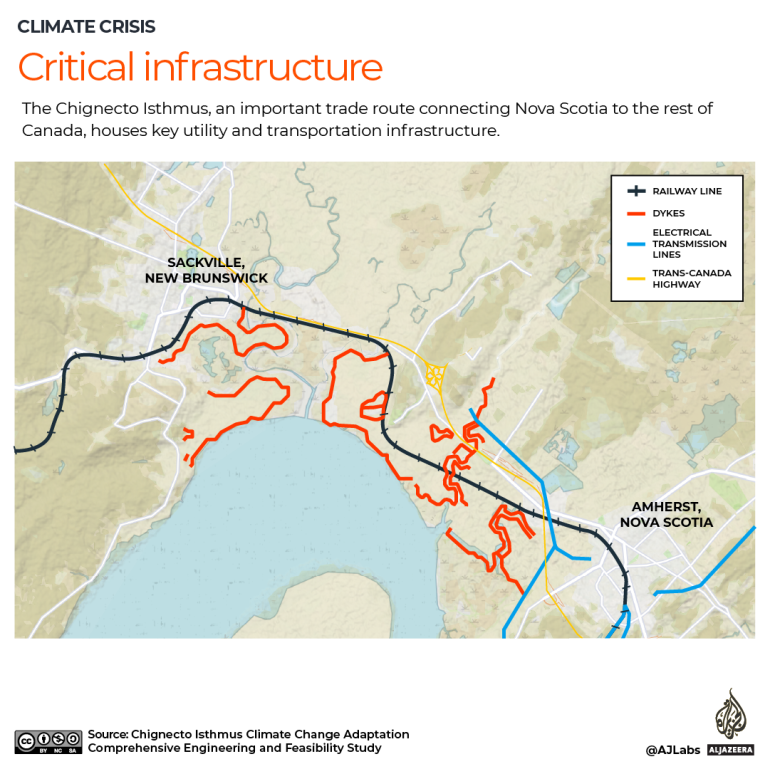Nova Scotia's fossil fuel projects are all in increasing trouble and some have been cancelled as costs mount both financially and due to the dawning of recognition of the havoc being created by climate change induced by fossil fuels. There is starting to be a shift towards renewable energy in Nova Scotia, but as always, the question remains will this be fast enough to avoid the worst effects of global warming here and elsewhere. Mi'kmaw protestors and environmental activists helped lead to the shutdown of AltaGas, while many other fossil fuel projects are also failing.
Cheryl Maloney, a Mi'kmaq activist, leads protesters to a blockade of a worksite near proposed AltaGas LNG site in 2016. It took years buttheproject was cancelled in October 2020.
The Donkin mine in Cape Breton was closed permanently in 2020. In addition to cost and financial problems, it was described as a disaster waiting to happen safety wise. Photo: Morien Resources Corp.
Several of Nova Scotia's energy megaprojects have fizzled in recent months and years, and some say the societal shift toward renewables is the reason. AltaGas, the company with a plan to store up to 10 billion cubic feet of natural gas in underground caverns, announced in October it was pulling the plug on the project due to the "repositioning of the business and the challenging nature of the storage project economics." In July, Pieridae Energy announced it would not proceed with its proposal to build a processing plant and export facility for liquefied natural gas in Goldboro, Guysborough County, citing cost pressures and time constraints.The future of the Bear Head LNG project, a proposal to bring in natural gas to Port Hawkesbury from Western Canada or the U.S., and then export it to Europe, is uncertain after the company behind the project tried to sell it last year.
The province's offshore oil and gas future looks less than rosy after a call for exploration bids this year yielded no interest. Last year, the Donkin coal mine — which produced both thermal coal for electricity generation and metallurgical coal for steelmaking — closed permanently, with the company blaming geological conditions in the underground mine. ...
Jennifer Tuck, the CEO of the Maritimes Energy Association, said the industry's transition away from fossil fuels is affecting the energy landscape in Nova Scotia. "Focus on climate change, achieving global emissions reductions targets, all of those things, I think, make it challenging in the fossil fuel sector," she said. Tuck said investment funds have been pulling out of funding oil and gas projects, and federal policy changes are focusing more on clean energies and technologies. ...
Community and global resistance to fossil fuels also likely played a role in the demise of some of Nova Scotia's energy megaprojects, said Noreen Mabiza, an energy co-ordinator at the Ecology Action Centre in Halifax. "It is definitely a factor, not a factor to be ignored," said Mabiza. "People have been on the ground for years saying they don't want these sorts of projects."
When AltaGas announced it was abandoning its natural gas storage plan, it said the project had received "mixed support, challenges and experienced delay." Mi'kmaw protestors and other opponents have long spoken out against the project, setting up a camp next to the Shubenacadie River and launching court challenges. "It takes years. It wasn't an overnight effort to get these projects to leave, but it's just that continued fight of people who want to fight and protect our land, and people who do recognize we are in a climate emergency and just certain things won't pass anymore," Mabiza said.
Larry Hughes, who teaches energy systems analysis at Dalhousie University and is a founding fellow of the MacEachen Institute for Public Policy and Governance, said there were different factors — including finances, logistical hurdles and opposition — involved in the demise of the different energy projects in Nova Scotia, but what was consistent was the hype behind each. Hughes said Nova Scotia has a "colonial mentality" when it comes to energy projects, primarily thinking about exporting resources such as gas or coal to other areas instead of using them at home first. "These projects get so hyped up by the province, that this is going to set us on the course to riches, we will become a have province, no more equalization payments.… There's a constant wishful thinking." ...
Hughes believes the province is at the beginning of a transition more toward renewables. "Unless BP went out and found a megafield that nobody had realized was out there and we did become Houston of the North, but unless something like that happens, there's nothing really on the non-renewable side on the cards that I can see," he said.
In October, the Nova Scotia government tabled legislation that would see coal-fired electricity generation phased out and 80 per cent of the province's power coming from renewables by 2030. Nova Scotia Power president Peter Gregg said the utility expects to meet the 80 per cent target largely through two renewable megaprojects, the Maritime Link and the Atlantic Loop.
Nova Scotia started receiving some electricity from Labrador's Muskrat Falls hydro project one year ago through the Maritime Link subsea cable. The Muskrat Falls project has been beset by difficulties, but is expected to deliver up to 60 per cent of Nova Scotia's electricity needs by the first half of 2022, Gregg said.
The Atlantic Loop project would see hydroelectric energy from Quebec and Labrador flow to Nova Scotia and New Brunswick through upgraded transmission grids. Gregg declined to estimate how long it may take to get the Atlantic Loop up and running, or how much of Nova Scotia's power would come from the project once it's completed. ...
Gregg said he's confident that even if the Atlantic Loop doesn't come to fruition by 2030, Nova Scotia Power will be able to meet the target through other means, noting the utility has a "portfolio of solutions" that includes onshore wind and grid-scale batteries to store wind energy. In 2020, 48 per cent of the utility's power came from coal, about 29 per cent came from renewable sources, 17 per cent came from natural gas and six per cent came from imports, according to Gregg.
https://www.cbc.ca/news/canada/nova-scotia/nova-scotia-energy-megaprojec...



 The company responsible for an abandoned LNG project in Nova Scotia has put a new plan on the table — a floating barge off the coast of Guysborough County.
The company responsible for an abandoned LNG project in Nova Scotia has put a new plan on the table — a floating barge off the coast of Guysborough County.












